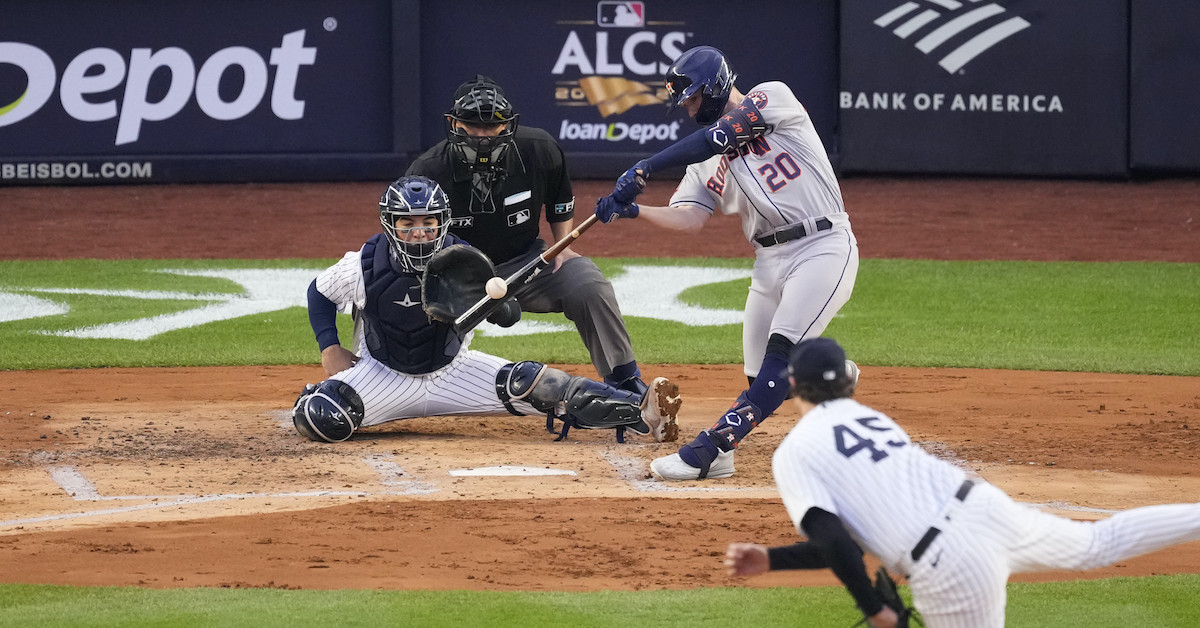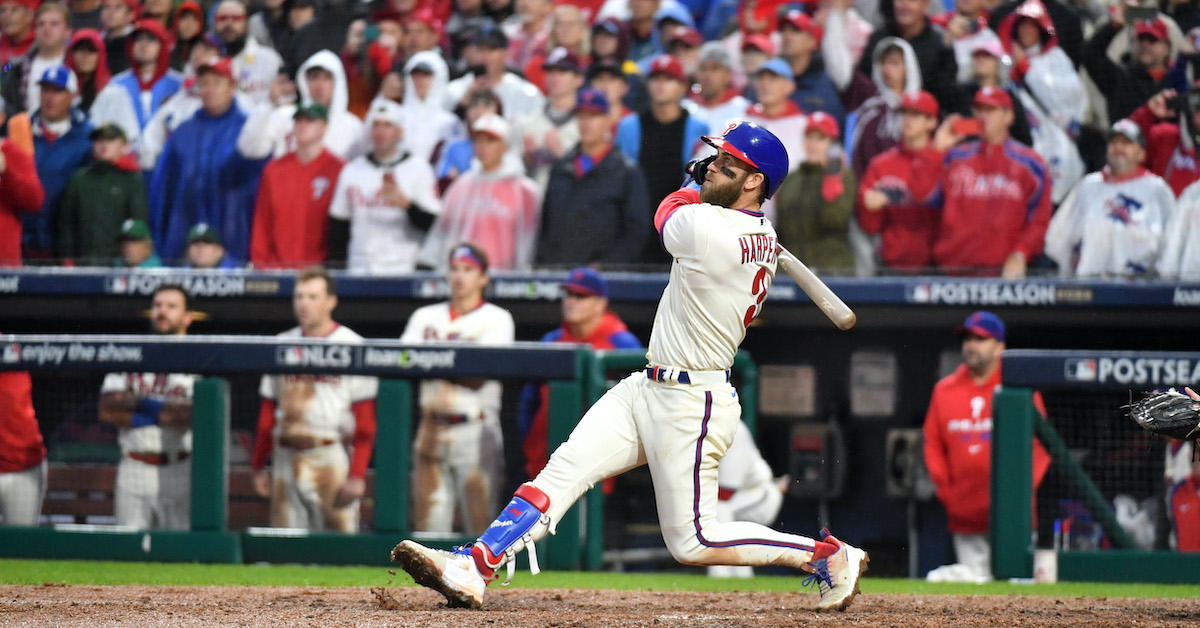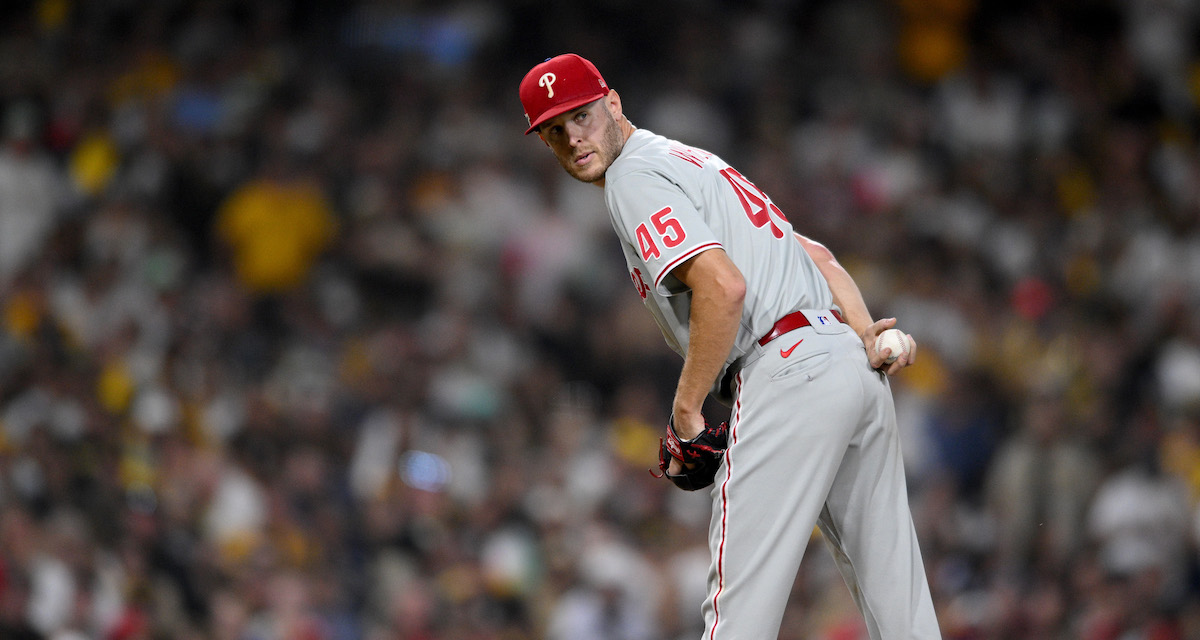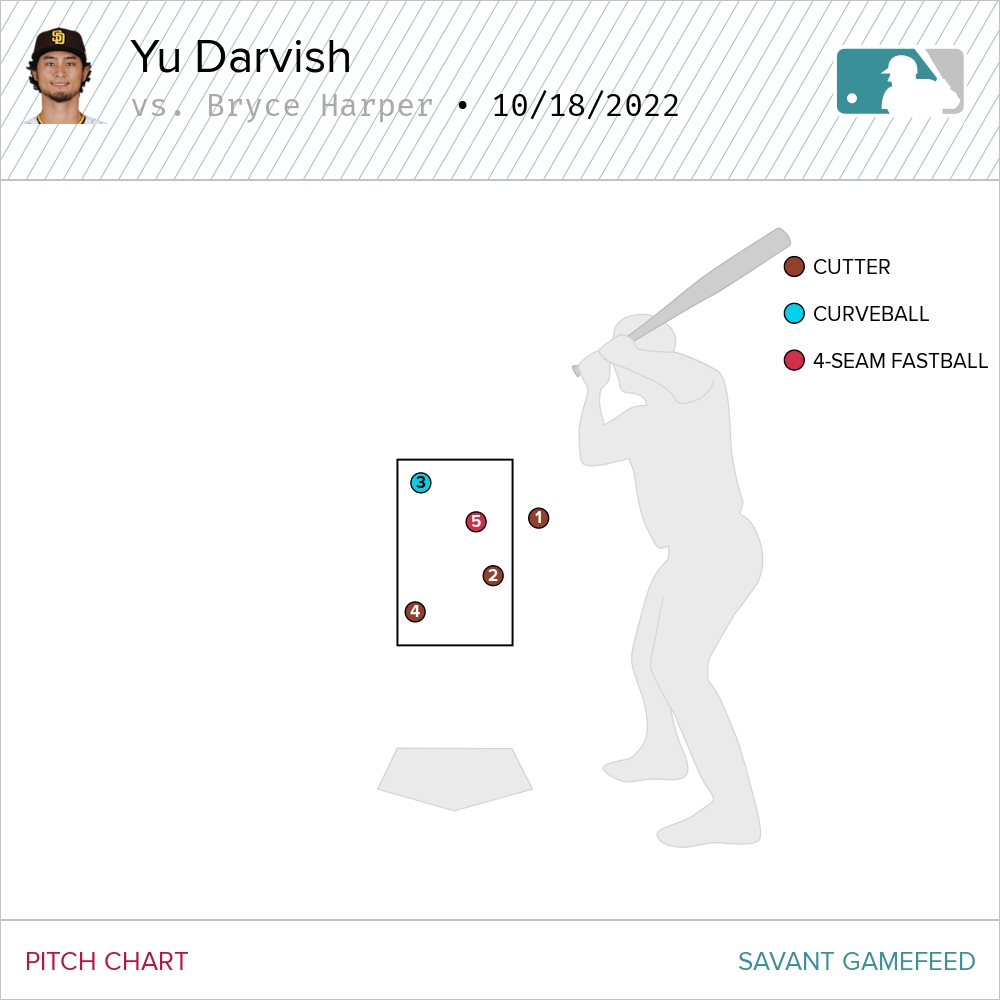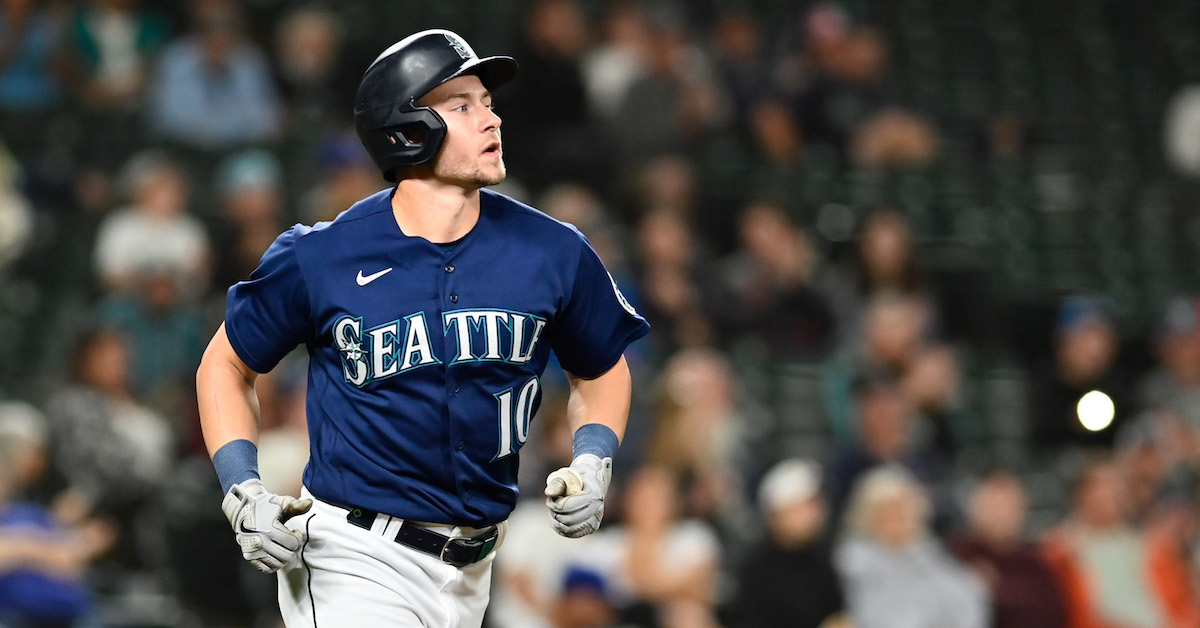Alex Bregman Is Punishing High Velocity Again
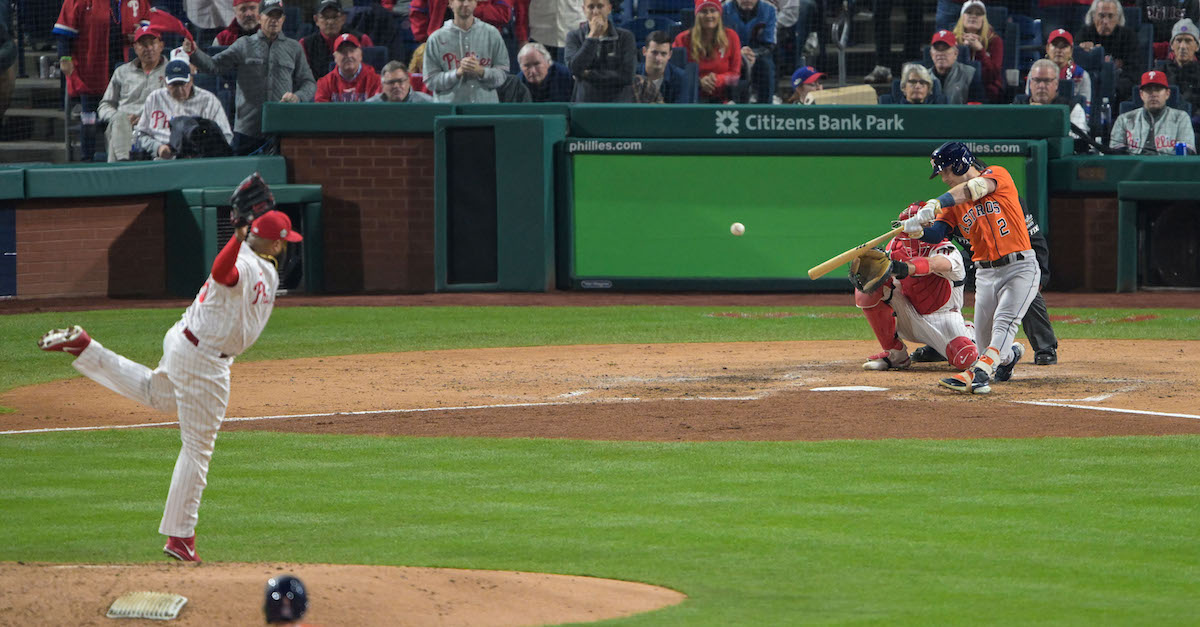
The field of hitters in the World Series is loaded. Both sides feature old and new stars who can tear the cover off the baseball. Perhaps unsurprisingly, Bryce Harper has been the most productive of all of them, with a .514 wOBA to this point. You have to go all the way down to the low .400s to find the next players on that list, but if you do, you see Jeremy Peña (.427 wOBA) and Alex Bregman (.407 wOBA). Peña has had the best stretch of his short career in these playoffs, delivering two-strike hit after two-strike hit. But the Astros third baseman, who has been penciled in right behind Peña and Yordan Alvarez, has also been fantastic.
There’s a reason Bregman is sitting fourth in the lineup behind three stars. His knack for not chasing breaking balls and getting to high velocity makes him an ideal hitter to follow Peña and Alvarez. Peña’s weakness is chasing sliders off the plate, while teams have consistently challenged Alvarez with high heat. But that approach has to change when facing Bregman, making it tough for any reliever to get through this stretch of the lineup unscathed. Interestingly, while Bregman’s chase rate hadn’t faltered at all, his ability to get to high velocity has only come around in the last month after a rough regular season, when Bregman posted a .242 wOBA against pitches thrown 96 mph or higher. To be honest, that surprised me. I know he doesn’t have crazy bat speed or hit the ball harder than most, but to the naked eye, he has one of the quickest triggers in the game.
When I say trigger, I’m referring to the time it takes Bregman to start his downswing and get to impact. If we were able to get our hands on his bat sensor data, I’d be very willing to bet this is where Bregman stands out amongst his peers. That skill makes him a great candidate to routinely beat high velocity. That’s a subjective thing to say without concrete data, but perhaps I can provide some video evidence. Let’s look to Game 3 of the ALCS:
Before this fastball, Bregman saw five upper-90s four-seamers from Gerrit Cole. If a very good hitter sees the same pitch six times in a row, I don’t doubt they’ll be able to make an adjustment like Bregman did here, even against Cole’s plus fastball. He had fouled off two heaters in this at-bat, and looked slightly late. Those swings, likely combined with the knowledge that Bregman had struggled with high velocity this year, was enough for Cole to stick to his guns and continue with the high heat. Unfortunately for him, Bregman adjusted by choking up and shortening his swing even further as he drilled this 100 mph fastball on the black right back up the middle at 105.7 mph.
By this time, Bregman had already laced a few liners off triple-digit fastballs. He had a hit in all three of his appearances against Andrés Muñoz in the ALDS, with the hits against fastballs coming in Games 2 and 3. Here they are:
Two fastballs over 101 mph, both of which were barreled over 105 mph to give Bregman a single and double, respectively. Both came on 0-0 counts, so I’m inclined to think Bregman was sitting on this pitch. He took Muñoz yard in Game 1 on a hanging slider, so he probably anticipated that the Mariners reliever wouldn’t go back to the pitch. Of course, even when you sit on a 101 mph fastball, you still have to barrel it. That’s a tough task for any hitter and Bregman made it look quite easy.
And it’s not as if Bregman was cheating his load or leg kick for those pitches against Cole and Muñoz. It looks natural for him to get his bat on plane and in the hitting zone very quickly. Given that, you might ask why Bregman was so bad against high velocity this year. As I said before, he had a .242 wOBA against these pitches, and it’s not like his .298 xwOBA was much better. Of the 23 home runs he hit in 2022, not a single one came on a fastball thrown 96 mph or higher. His swing type should enable him to hit these pitches well, but sometimes the eye test doesn’t align with a hitter’s outcomes. Still, by the looks of it, his performance in 2022 may have just been a blip. The following table shows Bregman’s performance against fastballs 96 mph and higher throughout his career:
| Year | Total >= 96 mph | Total Pitches | Hits | wOBA | xwOBA |
|---|---|---|---|---|---|
| 2017 | 69 | 2,302 | 8 | .381 | .360 |
| 2018 | 210 | 2,821 | 8 | .244 | .370 |
| 2019 | 198 | 2,915 | 12 | .440 | .427 |
| 2020 | 69 | 736 | 4 | .532 | .422 |
| 2021 | 104 | 1,593 | 8 | .322 | .359 |
| 2022 | 129 | 2,521 | 10 | .242 | .298 |
| Total | 929 | 12,888 | 50 | .327 | .363 |
The gap between his wOBA and xwOBA can probably be explained by a combination of bad BABIP luck and spray angle, but nonetheless, a career .363 xwOBA on this group of pitches is impressive. Focusing on just launch angle and exit velocity might miss out on some context, but it’s still a good representation of Bregman’s ability to hit these pitches hard in the air. If you exclude 2022 from the totals, Bregman’s wOBA/xwOBA split is .356/.385. Now, excluding 2022 isn’t exactly fair; this season did indeed happen! But I wanted to show you what Bregman had done before his struggles this year.
Even relative to the rest of the league, Bregman was a great hitter against high velocity. His .363 xwOBA against the pitch group since 2017 ranks him 26th in the league among hitters who have seen at least 750 of these fastballs. This was a proven skill that suddenly fell off hard in 2022 despite it being Bregman’s healthiest season in terms of games played since 2019. Sometimes a hitter’s mechanics get out of whack, and they just suddenly can’t handle a pitch they never had an issue with before. When that happens, it makes sense for high velocity to be the first thing a pitcher goes to. After all, fast things are hard to hit! After churning through swings from various months, I realized Bregman’s stride was slightly more open than it was in the playoffs. Here are two representative swings on inner-third pitches. The first is from June and the second is from September:
Unfortunately for Bregman, even such a small difference in stride direction made a huge difference in his batted ball quality. If you re-watch the swings from the playoffs, you can see Bregman staying near neutral to slightly closed. In the two swings above, Bregman’s stride leads to his front hip leaking out early. As a result, he flared a fly ball and chopped a groundball. The front foot rotation tells you where his direction is heading in both pitches. He is losing his center of balance while trying to throw his hands at the high velocity. His swing is so short that he is still able to get to it, but the slight mechanical difference distorts his bat path enough to ruin his contact quality. Now that we know this, we can better understand why Bregman has been so fantastic in the postseason from a mechanical perspective, but do the batted ball statistics match? Yes, they do indeed.
His .518/.468 wOBA/xwOBA split gives us additional context to the quality of contact Bregman made. There is a gap between the two, but it doesn’t really matter in this case. A .468 xwOBA is still a very, very high mark. He is on the short list of hitters who seem especially well equipped to deal with the high velocity playoff pitchers bring to the mound. The swings I showed you against Cole and Muñoz are good examples of that, but I’d like to take you through an at-bat from Game 4 of the World Series when Bregman faced José Alvarado. Bregman looked overmatched to start, but he eventually came out on top even though he was down 0-2 in the count. The bases were loaded with no outs. Alvarado came in to limit the damage. Here’s how it started:
On the 0-0 count, Bregman took this 101 mph sinker, which ran back over the front door. Coming from Alvarado’s arm slot, this pitch is a doozy. Good decision to take. Down 0-1, he had to be aggressive to try and drive a runner in:
Bregman was definitely swinging for a 101 mph sinker again. He didn’t recognize the spin, and the pitch broke under his barrel. He checked in with the umpire to see if the pitch was in the zone to reinforce his understanding of where it ends up after it breaks. Heading into the 0-2 count, Bregman had to cover the diving cutter and the turbo sinker:
This pitch was slightly higher than the previous one and allowed Bregman to get a little more of barrel on it. Realistically, you can’t cover every zone against Alvarado with the sweet spot of your barrel, as he has two pitches that break in opposite directions. This is the very best you can do if you’re simultaneously trying to beat 101. By the looks of it, Bregman had no problem doing so in the next pitch:
That pitch was meant to run over the front door like the first one, but Alvarado committed the biggest sin when it comes to front-door sinkers: He let it run over the middle of the plate and right into Bregman’s ideal bat path up and away. Bregman was doing his best to cover the high velocity while down in the count, and he did. In Game 1 of the series, he had a very uncomfortable at-bat against Alvarado and wasn’t able to cover the sinker or cutter. He knew he had to make a slight tweak to get a different result. Swings like this are why he leads all players in the postseason in hits (six) and wOBA (.518) against heaters 96 mph and above.
Don’t get me wrong, a .518 wOBA against the best fastballs isn’t sustainable. Not even Aaron Judge posted a wOBA like that while hitting every fastball to the moon this season. However, the combination of Bregman’s swing and career-long skill of hitting high velocity makes him significantly more capable of producing hot streaks like this one than the vast majority of players in the league. Here I’ll remind you that over the course of a season or a career, a player doesn’t perform to their average mark the entire way. There are hot and cold streaks wrapped in there that bring them to their true average. Bregman is having one of those hot streaks, and it couldn’t come at a better time.
As his team takes a crucial 3-2 lead heading back to Houston, don’t be surprised if Zack Wheeler and the rest of the Phillies’ pitching staff avoid heaters against Bregman. The Phillies have no room for error, which means they must avoid Astros hitters’ strengths. Right now, Bregman’s swing mechanics are locked in to beat these pitches and the Crawford Boxes are lurking in left field, just waiting for him to yank one out like he did against Luis Severino in the ALCS.

